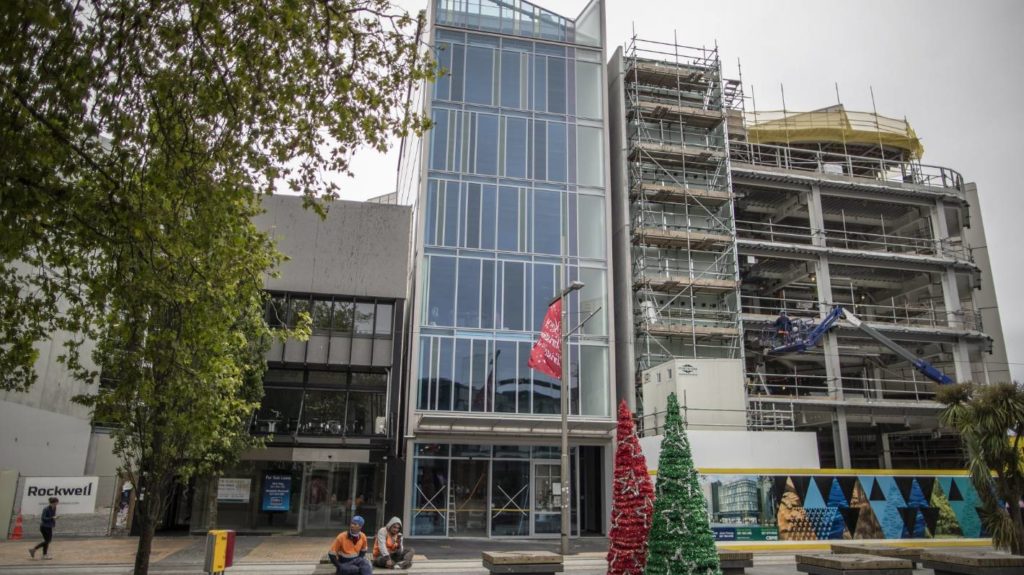[ad_1]
A property developer is suing the Christchurch City Council for $19 million over a blighted office block it wants to demolish in a busy central mall.
The two dozen court filings show claims and counterclaims flying over 230 High St, a thin eight-storey block finished in 2018 but never occupied since it was found to be structurally defective in 10 serious ways.
“The building poses risks to adjacent pedestrian walkways and users … [and] to adjacent and neighbouring properties,” the developer claims.
The documents also reveal claims that rigorous checks were not being done on structural designs.
READ MORE:
* Engineer behind faulty Christchurch office building found to be ‘incompetent’
* Defective central Christchurch high-rise still in limbo after two years
* More questions over Auckland skyscraper project’s building standards
The council states the external engineer it relied upon, WSP, “only spent two hours” reviewing the building’s superstructure design, and less than two hours each on two amended designs.
The council denies liability, but says if it is found liable, it was let down by three engineering firms, including WSP. The three all reject this.
Owner Hyung Sun Kim and his Rockwell development and construction companies state their losses at $19m and mounting – including from having to pay $116,000 in rates on an unusable building.
The plaintiffs claim the council consented the design and passed inspections without raising red flags, even after it was warned in late 2017 and launched its own investigation in mid-2018.
It “had a duty of care to investigate without delay”, they state.
The council “did not issue a stopwork notice” and did nine inspections after the 2017 warning, “giving the plaintiffs a false understanding” the issues were not serious.
The council states it had reasonable grounds to expect the building would be up to code, given what designers and engineers were telling it.
Iain McGregor/Stuff
The building at 230 High St, in central Christchurch, has never opened after serious defects were found.
The plaintiffs are also suing six others: foundations designer Blue Barn; foundations design peer reviewer ISPS; superstructure designers Joo Cho and his firm Seismotech, which also did construction monitoring; design peer reviewers Miyamoto International and council reviewer WSP.
A common defence is that the developers knew of the warnings in late 2017, but insisted things were OK.
They “elected not to pause construction”, did not call in an outside expert till 2019 and did not seek a design amendment, the council defence states.
Spotted on a night out
The defects were first exposed in November 2017 by a young engineer on a night out, peeking through a security fence.
He alerted his firm, Aurecon, and it began emailing the building’s structural designer, Seismotech.
“Aurecon identified issues from a cursory inspection, walking past the building for which they had no former involvement or engagement,” the owner/developers state.
After months of review and argument – that the developers claim they were left out of – the council in August 2018 refused to issue a code compliance certificate – the kiss of death.
The defects include weak or wrongly designed stairs, columns, piles, and hold-down bolts, and miscalculation of seismic loads.
“The foundations never complied with the building code,” state the plaintiffs, extending the problem period back to 2015 when consenting began, four years after the Christchurch earthquake, at a central city site close to damaged buildings and demolition sites.
Iain McGregor/Stuff
Defects in the building at 230 High St were first spotted by a young engineer who happened to be passing by.
In the end, three engineering firms separately panned 230 High St, with an ‘umpire’s call’ in late 2019, by firm Beca for the Ministry of Business, Innovation and Employment, sealing the building’s fate as unusable – though it remains standing amid arguments over whether to demolish or try to fix it.
Superstructure designer Seismotech continues to deny “that any concerns raised about the building were valid”.
It dismissed Aurecon as not understanding or having “insufficient experience” in the design methodology.
“The alleged defects were in fact all compliant and Seismotech demonstrated that with supporting calculations” to the council and ministry.
Seismotech owner Joo Cho’s defence repeatedly states: “Mr Cho is/was not personally responsible for that work in any way.”
Cho did not appeal against the ministry’s determination. He was deregistered by Engineering New Zealand this year.
The council claims the various review engineers breached their duty of care to the developers by failing to ensure the plans and specifications were good enough.
They maintain they did their job properly.
WSP (formerly Opus) had been doing checks for the council since 2012.
But while the council said WSP was meant to undertake “specialist structural engineering reviews” of 230 High St, WSP said its role was more limited.
It was limited to “up to four to five hours work for each consent”, and checked documentation was in order, and other tasks a building consent authority might do, rather than re-running design calculations.
RNZ has asked WSP and the council whether this apparent misunderstanding means other building designs have not been checked as thoroughly as they should have been since 2012.
The council cross-claim against WSP is for up to $5m; and for judgement, interest and costs against the other engineers if it is found liable.
Kim has a 2020 engineering report on 230 High St saying demolition is the only option; the $5.1m that would cost is part of the claim, as is $8.1m spent on the building.
The council is seeking outside advice on how to fix the building.
This story was originally published on RNZ.co.nz and is republished with permission.
[ad_2]
Source link
